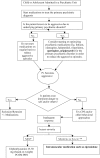Recommendations for pharmacological management of inpatient aggression in children and adolescents
- PMID: 20376274
- PMCID: PMC2848469
Recommendations for pharmacological management of inpatient aggression in children and adolescents
Abstract
Objective. While there has been a great deal of speculation by clinical researchers over the last three decades on effective and safe methods for the pharmacological management of aggression in children and adolescents, it is only in the last decade that there have been well-designed studies available to address this issue. Medication is commonly used to control aggression in children and adolescents in inpatient units. Also, there exists a need for evidence-based guidelines for the use of these different pharmacological agents for managing pediatric aggression on inpatient units. The aims of this article are to provide a systemic review and to provide treatment guidelines based on these limited but currently available studies.Methods. The articles reviewed in this study were obtained through a PubMed search using the key words 'children,' 'adolescents,' 'aggression,' 'inpatient,' 'ziprasidone,' 'lithium,' and 'risperidone.' A total of 499 studies were generated. Only studies focusing on pharmacological management of inpatient pediatric aggression with mean duration less than six weeks and published during January 1980 to August 2009 were included. Only English articles were considered. A total of 13 studies met these criteria, which were included in the review without any further statistical analysis. Recommendations are made on this available evidenced-based literature.Results. There is some evidence for the standing use of oral lithium, haloperidol, olanzapine, and risperidone for aggression related to specific psychiatric diagnoses. Intramuscular ziprasidone and olanzapine administered as needed were found to be effective for the rapid management of moderate to severe aggression. Oral or intramuscular diphenhydramine administered as needed was found to be useful for managing mild aggression due to a placebo effect.Conclusions. Studies are available on managing aggression in children and adolescents in inpatient treatment settings but are limited. Further studies on the use of various psychotropic medications are needed in order to develop comprehensive guidelines for the safe and effective pharmacological management of child and adolescent inpatient aggression.
Keywords: adolescents; aggression; antipsychotics; behavioral; children; inpatient; management; psychiatric; ziprasidone.
Figures
References
-
- Barzman DH, Findling RL. Pharmacological treatment of pathologic aggression in children. Int Rev Psychiatry. 2008;20(2):151–157. - PubMed
-
- Vitiello B, Hill JL, Elia J, et al. P.R.N. medications in child psychiatric patients: a pilot placebo-controlled study. J Clin Psychiatry. 1991;52(12):499–501. - PubMed
-
- Vitiello B, Ricciuti AJ, Behar D. P.R.N. medications in child state hospital inpatients. J Clin Psychiatry. 1987;48(9):351–354. - PubMed
-
- Srivastava A. Limited evidence for the effectiveness of p.r.n. medications among psychiatric inpatients. J Psychiatr Pract. 2009;15(3):193–201. - PubMed
-
- Chengappa KN, Levine J, Ulrich R, et al. Impact of risperidone on seclusion and restraint at a state psychiatric hospital. Can J Psychiatry. 2000;45(9):827–832. - PubMed
LinkOut - more resources
Full Text Sources
Miscellaneous

